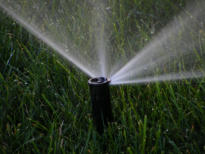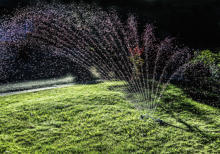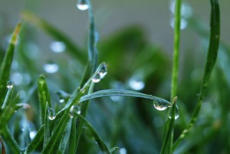
Watering



Ultralawn Incorporated
1055 East 260th Street
Euclid, OH 44132
216.731.7756
440.951.3738
Office hours Monday-Friday 9-3 call today with any questions
Turf studies show that most lawns need to be deep watered once every 3-4 days to stay healthy and green.
Watering every day creates shallow roots. Watering less frequently for
longer periods of time develops deeper, stronger roots and a healthier
turf. If grass does not spring back after being stepped on, it’s time to
water. Your lawn will also start to have a blue gray tint or color, if it is
too dry.
Keep in mind-
•
Turf grass plants are 70% to 75% water, which indicates the
importance of moisture in maintaining a vigorous, healthy, growing
plant. When grasses lose more water through the leaves than they
absorb through the root system, the plants become stressed.
•
The early stages of drought stress are seen as turf grass changing
colors from bright green to a dull gray or blue-green color.
Footprints and lawn mower wheel track remain for a period of time, and the grass does not spring back
upright. As plants begin to wilt the grass blades roll or fold. With additional stress, the turf loses its green
color and becomes yellow, then tan. A tan color indicates drought dormancy.
•
Grass plants that are in drought stress are often damaged by foot traffic and mowing. Do not mow lawns
that are in drought stress. The grass is not growing, and the plants have less moisture content to protect
the cellular structure from collapse and permanent damage. Mower wheels often leave stripes across the
lawn when the grass blades are broken and damaged by the weight of the wheels.
•
Some turf grasses, such as Bermuda grass and Tall Fescue, have more tolerance of low moisture conditions
than other grasses. Kentucky grass, Creeping Bent grass, Rye, and Fine Fescue are more prone to drought
stress and will lose green color quickly when soil moisture is low.
•
Heavy clay soils and sandy soils are not favorable for growing turf during periods of low moisture. The clay
holds the moisture so
tightly that grass roots
cannot retrieve moisture,
while sandy soils have a
low moisture holding
capacity.
•
Turf roots growing in
thatch rather than in soil
can result in a grass
more prone to drought
stress. Thatch is a layer
of dead but un-
decomposed roots and
stems above the soil.
Thatch acts like a sponge. It quickly absorbs rainfall, but also dries out rapidly, leaving plant roots dry even
after rainfall or watering.
•
Lawns mowed shorter than recommended for a grass type may have a shallow root system growing in the
soil. A shallow root system dries quickly even when thatch is minimal.
•
Water the lawn once grass begins to discolor and wilt. If it is not possible to water sufficiently to keep grass
green, water the lawn with at least 1/2 inch of water every 7 to 14 days. This light watering will help keep
the plants alive even if they are dormant.
•
Watering in the morning results in more efficient use of the water. Watering in the evening is satisfactory,
unless the lawn has a disease problem. For many homeowners without automatic irrigation systems, late
afternoon and evening is the only time of the day they can water the lawn. The time of the day is usually
not critical, however, watering in the heat of the day is not ideal due to the evaporation of water before the
water soaks into the soil.






Place a container in the irrigation water pattern and measure the water collected in the
container. If the water starts to run off the lawn before the desired amount is applied, move the
sprinklers or stop the irrigation and resume after a period of time.


















